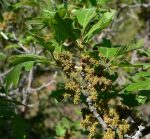 Also known as gambe oak, oak brush, and Rocky Mountain white oak, this deciduous small tree or large shrub is native to the foothills and lower mountains elevations of western North America including Arizona, New Mexico, Utah, Nevada, Wyoming, Idaho, Nebraska, Oklahoma panhandle, and western Texas. It is a member of the beech family, Fagaceae, that also includes chestnut. The trees usually grow 10-30′ tall but can reach 100′ or more where water is sufficient. They have furrowed or scaly, brownish gray bark and 3-4.5″ long leaves that have 3-6 irregular lobes and are glossy dark green above, lighter and hairy beneath but may turn orange, yellow or red in the fall. In spring male and female catkins of inconspicuous flowers appear on the same tree. The female catkins form in the leaf axils and if fertilized give way to solitary or paired green acorns that are less than an inch long, age to brown, and are 1/4 to 1/2 enclosed in a cap. Scrub oak spreads by both acorns and specialized tubers that allow the tree to sprout even after fires. The tree is drought tolerant and a good choice for naturalistic areas and woodlands as well as in containers and as bonsai. The genus name, Quercus, is the ancient Latin name for the plant. The specific epithet, bambelii, honors the American naturalist William Gambel (1821-1849) who discovered this oak in 1840 on the upper Rio Grande.
Also known as gambe oak, oak brush, and Rocky Mountain white oak, this deciduous small tree or large shrub is native to the foothills and lower mountains elevations of western North America including Arizona, New Mexico, Utah, Nevada, Wyoming, Idaho, Nebraska, Oklahoma panhandle, and western Texas. It is a member of the beech family, Fagaceae, that also includes chestnut. The trees usually grow 10-30′ tall but can reach 100′ or more where water is sufficient. They have furrowed or scaly, brownish gray bark and 3-4.5″ long leaves that have 3-6 irregular lobes and are glossy dark green above, lighter and hairy beneath but may turn orange, yellow or red in the fall. In spring male and female catkins of inconspicuous flowers appear on the same tree. The female catkins form in the leaf axils and if fertilized give way to solitary or paired green acorns that are less than an inch long, age to brown, and are 1/4 to 1/2 enclosed in a cap. Scrub oak spreads by both acorns and specialized tubers that allow the tree to sprout even after fires. The tree is drought tolerant and a good choice for naturalistic areas and woodlands as well as in containers and as bonsai. The genus name, Quercus, is the ancient Latin name for the plant. The specific epithet, bambelii, honors the American naturalist William Gambel (1821-1849) who discovered this oak in 1840 on the upper Rio Grande.
Type: Deciduous tree
Outstanding Feature: Fall color
Form: Founded
Growth Rate: Slow
Bloom: Inconspicuous flowers in male and female catkins on same plant in spring
Size: up to 150′
Light: Full sun
Soil: Average, medium moist to dry, well-drained, acidic alkaline; tolerates a wide range of soil condition,
Hardiness: Zones 4-7
Care: Low maintenance
Pests and Diseases: Susceptible to Beetle Borers, caterpillars, insect galls and scales, Armillaria, crown rot, mistletoe and root rot.
Propagation: Cuttings, seed
Photo Credit: Wikimedia Commons